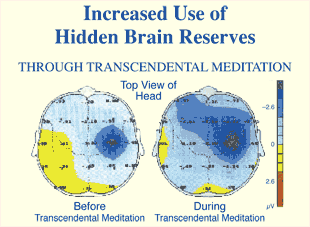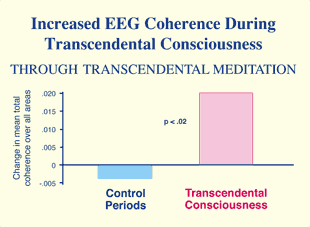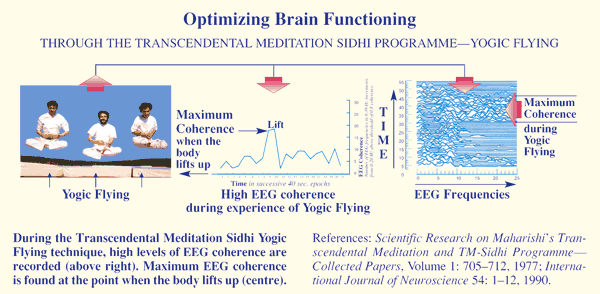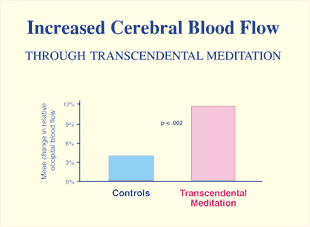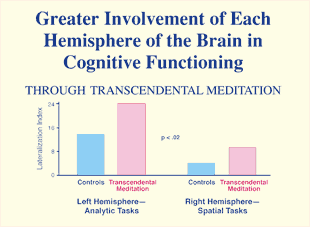
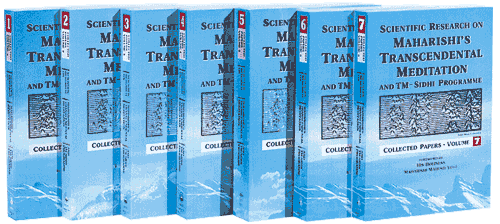
| ‘Through the window of science we see the dawn of the Age of Enlightenment.’ —Maharishi |
The following findings are a brief summary of the hundreds of scientific papers, relevant to the field of education, published in Scientific Research on Maharishi’s Transcendental Meditation and TM-Sidhi Programme: Collected Papers—Volumes 1–6 [over 5,000 pages; Volume 7 is in press]. More than 600 scientific studies, conducted at over 250 independent research institutions in 33 countries, objectively document the benefits of Maharishi’s Transcendental Meditation and TM-Sidhi Programme, and prove their extraordinary value to actualize the highest Vedic ideals of life, bringing fulfilment to the individual and to all areas of society. (Refer to: www.tm.org/research)
These studies are a record of the historic transformation of time, from the scientific age to the Age of Enlightenment, brought about by Maharishi’s teachings, which have opened the gates of enlightenment for millions of people, leading to the establishment of an ideal quality of life for the whole world—Heaven on Earth.
Scientific
Research Verifies that Consciousness-Based Education The Consciousness-Based Education of Maharishi Open University makes use of Maharishi’s Transcendental Meditation and TM-Sidhi Programme to develop higher integration of brain functioning and associated higher cognitive capabilities, as the basis for increasingly effective and rewarding thought and action. Maharishi’s Transcendental Meditation provides the experience of wholeness of awareness, unbounded awareness, in Transcendental Consciousness. Physiological research has established Transcendental Consciousness as a fourth major state of consciousness, a unique state of restful alertness distinct from waking, dreaming, and deep sleep, and characterized by enhanced integration of brain functioning. This and other research summarized below indicate that the experience of Transcendental Consciousness is essential for the total development of brain functioning. Maharishi’s Vedic Science brings to light that development of total brain potential is experienced as the development of higher states of consciousness. This enlivening of total brain functioning, and the corresponding actualization of mental potential, are the crucial missing elements in education today, and are provided by Consciousness-Based Education. Greater Integration of All Cortical
Areas (1) Use of the hidden reserves of the brain Professor Nicolaï N. Lyubimov, Head of Laboratory of Neurocybernetics, Moscow Brain Research Institute of the Academy of Medical Sciences, Russia, and President of Maharishi Vedic University in Moscow (until 1998), found that during Transcendental Meditation, when a light somatosensory stimulus was given to the skin, then the early components (less than 100 milliseconds) of the somatosensory evoked potentials of the brain, which are associated with sensory input, are more widely distributed in the brain structures—both in the brain hemisphere where the response usually occurs, as well as in the opposite hemisphere. (Please refer to chart below.) This finding indicates that during Transcendental Meditation ‘there is an increase in the area of the cortex taking part in the perception of specific information and an increase in the functional relationship between the two hemispheres’.
(2) Greater synchrony of brain functioning, measured at a full range of EEG frequencies of wakefulness and in all cortical areas Synchrony of electroencephalographic (EEG) activity reflects integrated functioning of large groups of neurones. EEG studies have found that during the practice of Transcendental Meditation, EEG activity is highly synchronized over almost all cortical areas; this synchrony was measured at all the categories of EEG frequencies associated with wakeful awareness (theta, alpha, and beta). At alpha frequencies (8–14 cycles per second) a stable alpha rhythm
often spreads to the whole cortical surface; at theta frequencies (4–7
cps) occasional hypersynchronous theta bursts are found over all cortical
areas, as well as rhythmic theta trains; and at beta frequencies (15–50
cps) generalized fast frequencies occur with a dominant beta rhythm of
about 20 cps, as well as smaller amplitude at 40 cps. Synchronous EEG
activity at all these frequencies and cortical areas reflects a global
integration of brain functioning.
EEG coherence measures the relationship between the EEG activity at two different locations on the scalp; it quantifies the consistency of phase relationship of the two EEG signals at a given frequency. Higher EEG coherence thus indicates greater integration of brain functioning in the measured areas. Research has found that during the practice of Transcendental Meditation, periods of time identified by respiratory changes as periods of Transcendental Consciousness displayed a significant increase in EEG coherence, averaged over all the measured frequencies (1–50 cps) and cortical locations (nine pairs of electrodes). (Please refer to chart on the right above.) This finding indicates that during Transcendental Consciousness there
is increased integration of brain functioning, as reflected in the full
range of EEG frequencies and cortical areas measured.
Periods of very high EEG coherence in all pairs of electrodes were found associated with clear experiences of the TM-Sidhi Programme; maximum EEG coherence occurred immediately before the body lifted off the ground in the TM-Sidhi practice of Yogic Flying. (Please refer to chart below.) Subsequent research also found that EEG coherence
over all measured scalp areas and over a broad band of frequencies
(4.7–17.9 cps)
increased significantly immediately before the body lifted off the ground
in Yogic Flying.
Research reviewed in Part One has shown that during specific cognitive processes such as reading, speaking, and memory encoding or retrieval, blood flow increases only in very isolated parts of the cortex. However, research on Transcendental Meditation has found that during this practice there is increased cerebral blood flow in both frontal and occipital parts of the cortex, reflecting an integrated state of cortical activity extending over large areas of the brain. (Please refer to chart on left side below.) This finding of increased cerebral blood flow also indicates a state of inner alertness during Transcendental Meditation, because in contrast, during light sleep, there is a decrease in relative cerebral blood flow. This finding also contrasts to the long-term effects of the ageing process; cerebral blood flow usually decreases with ageing. All the findings described above—greater use of the hidden or latent reserves of the brain, increased synchrony and coherence of electroencephalographic activity at diverse frequencies and cortical locations, and increased cerebral blood flow widely throughout the cortex—all reflect greater integration of brain functioning during Transcendental Meditation.
|
A Brief Summary of Results
An analysis of findings which demonstrate the ability of Maharishi’s
Transcendental Meditation and TM-Sidhi Programme to unfold the
creative intelligence of the student and of society as a whole,
so that every citizen can enjoy increasing success and fulfilment in life
[The numbers within parentheses after each finding
refer to the numbers of the
original research studies as printed in the six volumes of the Collected Papers.]
Optimizing Brain Functioning
- Increased Orderliness of Brain Functioning (Vol. 1: 1–4, 14–18, 20, 102; Vol. 2: 115, 117, 121; Vol. 3: 205, 210, 211, 213, 215, 217, 218, 224; Vol. 4: 294–296)
- Increased Integration of Brain Functioning (Vol. 1: 14–17, 20, 102; Vol. 3: 205, 210, 211, 213, 215, 217, 218, 224; Vol. 4: 294–296; Vol. 5: 370, 371, 375)
- Increased Brainwave Coherence (Vol. 1: 20, 21, 102; Vol. 3: 205, 210, 213, 215, 217, 218, 224; Vol. 4: 294, 296; Vol. 5: 370, 371)
- Increased EEG Coherence at the Moment of Performance of the TM-Sidhi Technique of Yogic Flying (Vol. 1: 102; Vol. 5: 375)
- Increased EEG Coherence during Acquisition of New Information Found in Participants of Maharishi’s Transcendental Meditation Programme (Vol. 5: 372)
- Increased Blood Flow to the Brain (Vol. 2: 105, 106; Vol. 3: 194, 195)
- Increased Neurological Efficiency:
- Increased Efficiency of Information Transfer in the Brlain (Vol. 2: 114, 116; Vol. 3: 214, 251; Vol. 5: 374)
- Improved Spinal Reflex Activity (Vol. 3: 226, 227, 229)
- Improvements in Reaction-Time Measures That Are Correlated with Intelligence (Vol. 5: 390)
- Greater Ability to Process Information at Speed (Vol. 2: 123)
- Improved Right Hemispheric Functioning—Improved Synthetic and Holistic Thinking (Vol. 1: 103; Vol. 2: 135, 140; Vol. 3: 257, 260; Vol. 5: 393)
- Increased Sensitivity, Strength, and Flexibility of the Nervous System (Vol. 4: 301)
- Greater Adaptability of Brain Functioning (Vol. 2: 120)
- Increased Order-Producing Activity of the Brain during Sleep (Vol. 5: 373)
- Faster Processing of Cognitively Complex Information in the Elderly (Vol. 5: 374)
- Correlations Found in Subjects Practising Maharishi’s Transcendental Meditation and TM-Sidhi Programme:
- Between Duration of Practice of Transcendental Meditation and High EEG Coherence (Vol. 4: 296)
- Among High EEG Coherence, High Levels of Creativity, Neurological Efficiency, and Experience of Transcendental Consciousness (Vol. 1: 21)
- Among High EEG Coherence, Experiences of Higher States of Consciousness, Quality of Experiences of the TM-Sidhis, and High Levels of Creativity (Vol. 1: 102; Vol. 3: 216)
- Between Increased Frontal EEG Coherence and Increased Creativity (Vol. 4: 294)
- Between Flexibility of Concept Learning and Both High EEG Coherence and Neurological Efficiency (Vol. 3: 219)
- Between Neurological Efficiency and Both High EEG Coherence and Superior Academic Performance (Vol. 3: 230, 231)
- Between High EEG Coherence and Superior Performance in Mathematics (Vol. 3: 221)
- Between High EEG Coherence and Greater Moral Maturity, Greater Intelligence, Superior Academic Performance, and Lower Neuroticism (Vol. 4: 294)
- Between High EEG Coherence and Both High Levels of Principled Moral Reasoning and a Unified Cosmic Perspective on Life (Vol. 3: 223)
- Between High EEG Coherence and More Ideal Social Behaviour (Vol. 4: 297)
- Between High EEG Coherence and Superior Performance on Age-Related Psychological Variables (Vol. 3: 225)
Increased Intelligence, Learning Ability, and Intellectual Performance
- Increased Intelligence (Vol. 1: 53–55, 62, 103; Vol. 2: 150; Vol. 3: 257, 261, 265; Vol. 4: 307; Vol. 5: 382, 387, 389, 390, 392, 393)
- Increased Intelligence Growth Rate (Vol. 1: 54; Vol. 3: 265; Vol. 5: 389, 390)
- Increased Learning Ability (Vol. 1: 56, 57; Vol. 3: 265; Vol. 4: 300; Vol. 5: 380, 385, 386)
- Improved Concentration (Vol. 2: 132)
- Improved Comprehension (Vol. 2: 132)
- Increased Mental Clarity and Wakefulness (Vol. 2: 147)
- Improved Intellectual Performance (Vol. 1: 62)
- Improved Problem-Solving Ability (Vol. 1: 58, 62)
- Improved Ability to Deal with the Abstract and Complex (Vol. 1: 62)
Improved Academic Performance and Increased Academic Orientation
- Improved Academic Performance (Vol. 1: 59–61; Vol. 4: 306; Vol. 5: 385–387, 391)
- Improved Standardized Test Scores on General Academic Achievement, Social Studies, Literary Materials, Reading, Mathematics, Language, and Work/Study Skills (Vol. 5: 385, 386)
- Greater Interest in Academic Activities (Vol. 1: 71; Vol. 2: 138; Vol. 4: 304)
- Greater Commitment to Higher Education (Vol. 2: 138; Vol. 4: 304)
- Greater Intellectual Orientation (Vol. 1: 71; Vol. 2: 138; Vol. 4: 304)
- Greater Scientific Orientation (Vol. 2: 138)
- Greater Aesthetic Orientation (Vol. 1: 71; Vol. 2: 138)
- Enhanced Academic Atmosphere in a University Setting (Vol. 4: 304)
- Increased Influence in Decision Making by Teachers concerning Classroom Instruction (Vol. 5: 388)
Increased Creativity
- Enhanced Creativity (Vol. 1: 62, 63, 103; Vol. 2: 150; Vol. 3: 257, 260; Vol. 4: 294, 304, 305; Vol. 5: 392, 395)
- Increased Resourcefulness (Vol. 2: 150, 153)
- Increased Innovation (Vol. 1: 62)
Implications of Total Brain Development for Education
The neurological and neurocognitive research findings above indicate that the prevailing systems of education are failing to develop the full brain potential of every student; as a result education everywhere is unable to realize its highest goals.
Research shows that experience directly shapes the development and modification of brain functioning. Research also suggests that the type of experience most valuable for brain development after childhood is greater integration of brain functioning, which is not systematically provided by education.
Many aspects of cognitive functioning have their basis in the growth of higher, or more integrated, brain functioning. Despite the efforts of educators applying a variety of teaching and curriculum approaches, these cognitive abilities have been found to stop developing after adolescence. This lack of continued growth of cognitive abilities is compelling evidence that education fails to continue unfolding the full brain potential of each student.
Research also shows that the brain continues to adapt its functioning to specific channels of learning and behaviour. The cognitive activities typically exercised in education (reading, speaking, memorizing and recall), as well as specific categories of knowledge, activate highly specific areas of the brain, rather than promote more holistic or integrated brain functioning.
The conclusion from the above research findings is that the segmented approach to knowledge that characterizes education today restricts the awareness and brain functioning to narrow channels of activity. Restricted awareness leads to problems, mistakes, and the inability to evaluate the environment and act in a way that consistently favours progress and happiness.
The research findings in neuroscience, physiology, and psychology verify the development of higher integration of brain functioning, and correspondingly, the progressive unfoldment of mental potential, through the technologies of Consciousness-Based Education, the Transcendental Meditation and TM-Sidhi Programme.
Research shows greater integration of all cortical areas during the practice of these Technologies of Consciousness, as measured by synchrony and coherence of EEG activity at diverse frequencies, by greater use of the latent reserves of the brain, and by increased cerebral blood flow throughout large areas of the cortex.
Participants in the Transcendental Meditation and TM-Sidhi Programme also show, outside the practice, an integration of different styles of brain functioning, including greater activation of each brain hemisphere; and a unique integration of EEG, associated with the experience of higher states of consciousness. They also display greater efficiency and integration of brain functioning at the basis of cognitive processes, as measured by faster brain processing of cognitive and sensory stimuli; and by development of cognitive abilities that are associated with more integrated brain functioning—abilities previously found to stop developing in adolescence, after the initial maturation of the brain. These findings show that the development of brain potential and of mental potential are simultaneous through the practice of Maharishi’s Technologies of Consciousness.
The research on the Transcendental Meditation and TM-Sidhi Programme also indicates greater integration and effectiveness in the total functioning of the brain, the peripheral nervous system, and neuroendocrine processes. This is evident from more adaptive responses to stress by the autonomic nervous system and the endocrine system; as well as by reversal of the detrimental effects of the ageing process, as measured in a broad spectrum of physiological, cognitive, and behavioural variables.
The conclusion of this research, supported by more than 600 research studies on the Transcendental Meditation and TM-Sidhi Programme and over forty years of educational experience, is that it is now possible to develop brain functioning in its totality, for the enrichment of all aspects of life—mental potential, health, behaviour, and the society as a whole. (Please refer to the Scientific Research on Maharishi’s Transcendental Meditation and TM-Sidhi Programme—Collected Papers, Volumes 1–6.)
Educators who are sincere in their desire to do the most for their students and to eliminate the weaknesses of education will avail themselves of this knowledge and offer Consciousness-Based courses through their educational systems. The result will be generations of students who are enlivening their total brain functioning, on the basis of which they will lead increasingly problem-free, productive, and fulfilling lives, directly contributing to progress in every area of national life.
Improved Athletic Performance
- Improved Mind-Body Coordination (Vol. 1: 53; Vol. 2: 130)
- Increased Running Speed (Vol. 1: 58; Vol. 2: 130)
- Increased Agility (Vol. 1: 53; Vol. 2: 130)
- Improved Standing Broad Jump (Vol. 1: 53; Vol. 2: 130)
Increased Organizational Ability and Efficiency
- Increased Time Competence: Increased Ability to Think and Act Efficiently in the Present (Vol. 1: 69, 70, 76, 94; Vol. 2: 151, 153, 155)
- Greater Ability to Achieve More with Less Effort (Vol. 2: 164)
- Greater Organizational Ability (Vol. 2: 164)
- Increased Foresight (Vol. 2: 153)
- Greater Initiative (Vol. 2: 164)
- Increased Morale, Facilitative Leadership, and Increased Influence in Decision Making concerning Classroom Instruction in Teachers Practising Maharishi’s Transcendental Meditation Technique (Vol. 5: 388)
Increased Energy and Dynamism
- Growth of a More Brave, Adventurous, Action-Oriented Nature (Vol. 1: 73)
- Greater Physical Well-Being (Vol. 4: 308)
- Decreased Drowsiness (Vol. 2: 126, 147)
- Decreased Lethargy (Vol. 2: 126, 147)
- Decreased Fatigue (Vol. 2: 147; Vol. 3: 238; Vol. 4: 308; Vol. 5: 399)
Increased Integration of Personality and
Growth of Higher States of Consciousness
- Experience of Pure Consciousness during the Practice of Maharishi’s Transcendental Meditation Technique (Vol. 1: 2, 7, 8, 21, 99–102; Vol. 3: 197, 205, 213, 216, 218, 258)
- More Frequent Experiences of Higher States of Consciousness (Vol. 5: 397)
- Growth of Experiences of Higher States of Consciousness (Vol. 1: 7, 19, 102–104; Vol. 3: 216, 258, 284; Vol. 4: 312; Vol. 5: 395, 397)
- Increased Self-Actualization: Increased Integration, Unity, and Wholeness of Personality (Vol. 1: 64, 67, 69, 70, 72, 74, 76, 78, 94; Vol. 2: 139, 144, 151, 153, 155; Vol. 3: 239; Vol. 5: 395)
- Greater Ability to Bring the Inner Self to Healthy Expression (Vol. 2: 141)
- Increased Inner-Directedness: Greater Independence and Self-Supportiveness (Vol. 1: 64, 69, 70, 72, 76, 94; Vol. 2: 139, 151, 153, 155; Vol. 3: 268)
- Greater Inner Locus of Control (Vol. 1: 69; Vol. 4: 314)
- Increased Autonomy and Independence (Vol. 1: 62, 71; Vol. 2: 151, 153; Vol. 5: 395)
- Enhanced Self-Regard and Self-Esteem (Vol. 1: 62, 64, 67, 69, 76, 90; Vol. 2: 139, 151, 153, 156, 158; Vol. 3: 239, 266, Vol. 5: 371)
- Increased Self-Confidence and Self-Assuredness (Vol. 1: 65, 77; Vol. 2: 150, 164; Vol. 3: 261, 277, 290; Vol. 4: 308)
- Greater Inner Calm and Tranquillity (Vol. 1: 65, 73, 77; Vol. 2: 150; Vol. 4: 308, 316)
- Greater Optimism (Vol. 2: 138)
- Greater Open-Mindedness: Greater Flexibility of Constructions of Reality (Vol. 2: 152)
- Increased Ability to See the Opposites of Life as Meaningfully Related (Vol. 1: 76)
- Increased Ability to Connect Past, Present, and Future Meaningfully (Vol. 1: 69, 70, 76, 94; Vol. 2: 151, 153, 155)
Increased Freedom from Stress
- Reduction in Biochemical Indices of Stress:
- Decreased Arterial Lactate Levels (Vol. 1: 2–4; Vol. 3: 194, 203, 207; Vol. 4: 291, 292)
- Decreased Plasma Cortisol Levels (Vol. 1: 12; Vol. 2: 109, 111; Vol. 3: 190, 191, 200, 202)
- Decreased Urinary Free Cortisol Levels (Vol. 2: 109)
- Increased Autonomic Stability (Vol. 1: 25–28, 87; Vol. 2: 123, 130; Vol. 3: 197, 205; Vol. 5: 356)
- More Effective Interaction with the Environment: Improved Resistance to Stress (Vol. 1: 25–28; Vol. 2: 123; Vol. 5: 370)
- Maintenance of a Relaxed Style of Physiological Functioning outside of the Practice of Maharishi’s Transcendental Meditation Technique (Vol. 1: 6, 18, 30; Vol. 3: 197; Vol. 5: 356, 358, 359)
Reduction in Negative Personality Characteristics
- Decreased Anxiety (Vol. 1: 33, 35, 61, 62, 68, 71, 72, 74, 75, 78, 81, 84, 88–90, 92, 93, 95; Vol. 2: 125, 133, 138, 143, 145, 148, 150, 153, 154, 157, 160; Vol. 3: 234, 238, 243, 268, 273, 275, 278, 280, 281, 284, 288, 290; Vol. 4: 308, 310, 311, 313, 314, 316; Vol. 5: 370, 399)
- Decreased Tension (Vol. 1: 65, 77, 81; Vol. 2: 157, 161; Vol. 3: 277, 281, 284, 290; Vol. 4: 308; Vol. 5: 399)
- Decreased Nervousness (Vol. 1: 65, 77; Vol. 2: 147; Vol. 3: 239, 273, 277, 290; Vol. 4: 308, 316)
Growth of Ideal Social Behaviour
- Increased Ability to See Man as Essentially Good (Vol. 1: 76; Vol. 2: 153; Vol. 3: 266)
- Increased Social Maturity (Vol. 2: 138; Vol. 3: 261)
- Greater Sense of Social Responsibility (Vol. 2: 138, 158)
- Less Sense of Social Inadequacy (Vol. 3: 266)
- Increased Outgoingness and Tendency to Participate (Vol. 1: 73; Vol. 2: 150, 153)
- Increased Ability to Cooperate with Others (Vol. 1: 73; Vol. 2: 161, 164)
- Increased Ability to Be Objective, Fair-Minded, and Reasonable (Vol. 4: 316)
- Increased Sensitivity to the Feelings of Others (Vol. 1: 73; Vol. 4: 304, 316)
- Growth of a More Tactful, Forgiving, and Agreeable Nature (Vol. 1: 73; Vol. 2: 153)
- Greater Regard for Etiquette (Vol. 2: 153)
Benefits in Special Education
- Increased Self-Actualization with Regard to Aspects of Personality Relevant to Learning Disorders in Economically Deprived Adolescents with Learning Problems:
- Increased Independence and Self-Supportiveness (Vol. 2: 139)
- Improved Self-Regard (Vol. 2: 139)
- Decreased Dropout Rate from School in Economically Deprived Adolescents with Learning Problems (Vol. 2: 139)
- Benefits for Children with Learning Problems:
- Decreased Anxiety (Vol. 2: 133)
- Decreased Examination Anxiety (Vol. 2: 133)
- Decreased School Dislike (Vol. 12: 33)
- Improvements in Autism: Decreased Echolalic Behaviour (Vol. 3: 262)
- Benefits for Mentally Retarded Subjects:
- Improved Social Behaviour (Vol. 3: 263)
- Improved Cognitive Functioning (Vol. 3: 202, 263)
- Increased Intelligence (Vol. 3: 202)
- Improved Physiological Functioning (Vol. 3: 263)
- Normalization of Neurotransmitter Metabolite and Plasma Cortisol Levels (Vol. 3: 202)
- Decreased Stuttering (Vol. 1: 43; Vol. 4: 298)
Creation of an Ideal Society through the Maharishi Effect—
Improved Quality
of City, Provincial, National, and International Life
The following research findings demonstrate that one per cent of a population practising Maharishi’s Transcendental Meditation Technique or the square root of one per cent collectively practising Maharishi’s TM-Sidhi Programme radiates a powerful influence of coherence and harmony in collective consciousness, bringing life in accordance with all the Laws of Nature, neutralizing negative tendencies and promoting positive trends in society as a whole.
- Improved Quality of National Life as Measured by an Index Including Degrees Conferred per Capita, Patent Application Rate, Crime Rate, Percentage of Civil Cases Reaching Trial, Rate of Infectious Diseases, Infant Mortality Rate, Suicide Rate, Cigarette Consumption Rate, Alcohol Consumption Rate, Gross National Product per Capita, Divorce Rate, and Traffic Fatality Rate (Vol. 4: 332, USA, 1976–1983)
- Improved Quality of Provincial Life as Measured by an Index Including Mortality Rate, Cigarette Consumption Rate, Beer Consumption Rate, Motor Vehicle Fatality Rate, Auto Accident Rate, Pollution, Unemployment Rate, and Total Crime Rate (Vol. 4: 321 and Vol. 5: 401, Rhode Island, USA, 1978)
- Increased Creativity as Measured by Increased Patent Applications (Vol. 4: 337, USA, Australia, South Africa, and United Kingdom, 1983–1984)
- Increased Confidence, Optimism, and Economic Prosperity: Improvement in Economic Indicators (Vol. 4: 323, USA, 1979; 329, Washington, DC, USA, 1981–1983; 330, United Kingdom, 1982–1983; 333, Israel, 1983; 335, Lebanon, 1984; 336, Worldwide, 1983–1984; 337, Worldwide, 1983–1984; Vol. 5: 411, Worldwide, 1983–1985)
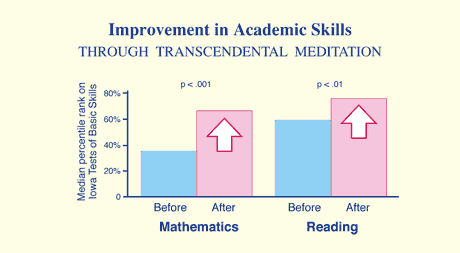
| Within one school year, elementary school students who practised the Transcendental Meditation Programme showed significant gains on a nationally standardized test of basic skills. Reference: Education 107: 49–54, 1986. |
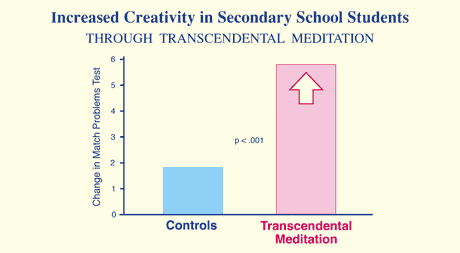
| Secondary school students who learnt the Transcendental Meditation Programme showed increased creativity after 14 weeks, in contrast to control students. Reference: Dissertation Abstracts International 38(7): 3372B–3373B, 1978. |
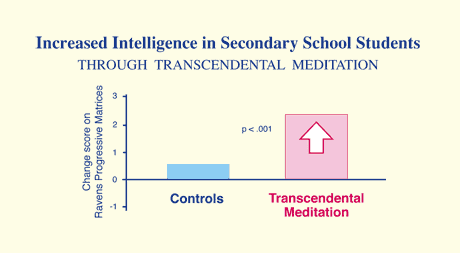
| Secondary school students who learnt the Transcendental Meditation Programme showed increased intelligence after 14 weeks, in contrast to control students. Reference: Dissertation Abstracts International 38(7): 3372B–3373B, 1978. |

| University students who were practising Maharishi’s Transcendental Meditation and TM-Sidhi Programme increased significantly on intelligence, in contrast to control students. Reference: Personality and Individual Differences 12: 1105–1116, 1991. |
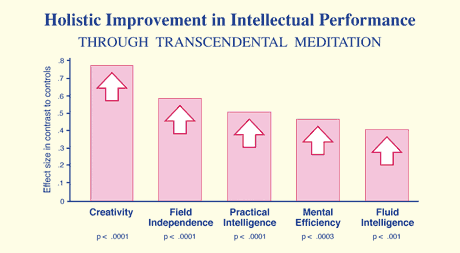
| Three randomized controlled studies among Chinese students found that, in contrast to controls, those who learnt Maharishi’s Transcendental Meditation showed significant improvement in five measures of intellectual functioning; they also showed decreased anxiety. Reference: Dissertation Abstracts International 56(6): 2178A, 1995. |
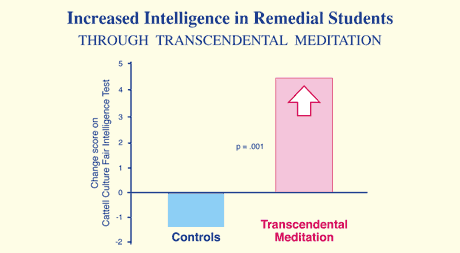
| This study was conducted among Cambodian students taking a year of remedial study in preparation for college. Students who learnt the Transcendental Meditation Programme showed a significant increase in intelligence test scores, in contrast to other students after three months. Reference: Higher Education Research and Development 15: 73–82, 1995. |
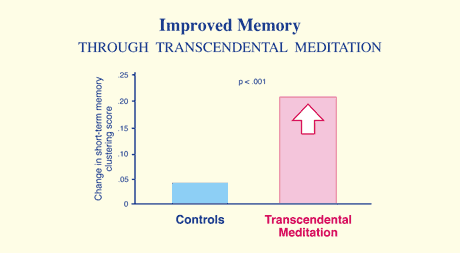
| University students who learnt the Transcendental Meditation Programme showed after 40 days improved clustering in short-term memory, indicating increased organization of the thinking process, in comparison to randomly assigned controls who sat with closed eyes twice daily. Reference: Scientific Research on the Transcendental Meditation Programme: Collected Papers, Volume 1: 385–392, 1977. |
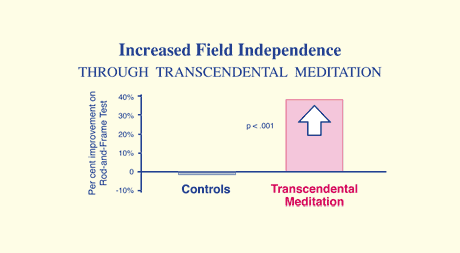
| Individuals randomly assigned to learn Maharishi’s Transcendental Medi-tation Programme displayed a significant increase after three months, in comparison to controls, on measures of field independence, indicating broader comprehension with increasing ability to focus. Reference: Perceptual and Motor Skills 39: 1031–1034, 1974. |

| University students who learnt Maharishi’s Transcendental Meditation Programme showed a significant increase in grade point average over the next three grading periods, in comparison to control students. Reference: Scientific Research on Maharishi’s Transcendental Meditation Programme—Collected Papers, Volume 1: 396–399, 1977. |
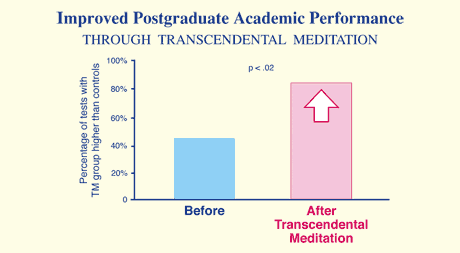
| Master degree engineering students who learnt Maharishi’s Transcendental Meditation Programme showed improved performance on their standard examinations after six months, compared with randomly assigned controls. Reference: British Journal of Educational Psychology 55: 164–166, 1985. |
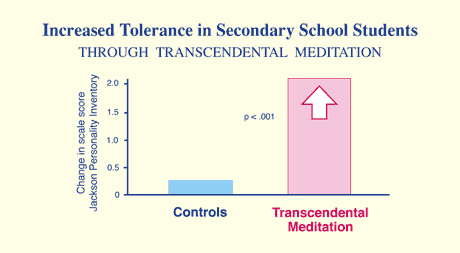
| Secondary students who learnt the Transcendental Meditation Programme showed increased tolerance after 14 weeks, in contrast to control students. Reference: Dissertation Abstracts International 38(7): 3372B–3373B, 1978. |
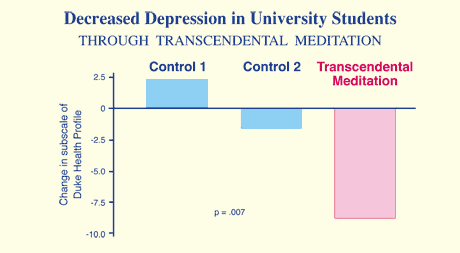
| University students in Cambodia who began the Transcendental Meditation Programme showed decreased depression after three months, in contrast to groups of students from two other universities who did not learn the Transcendental Meditation Programme. Reference: Journal of Instructional Psychology 22: 308–319, 1995. |
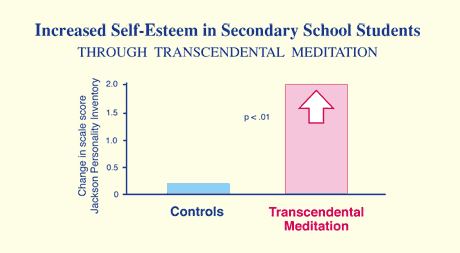
| Secondary school students who learnt the Transcendental Meditation Programme showed increased self-esteem after 14 weeks, in contrast to control students. Reference: Dissertation Abstracts International 38(7): 3372B–3373B, 1978. |

| Secondary school students with learning disabilities who were instructed in the Transcendental Meditation Programme showed increased self-regard, in contrast to control students participating in a guidance group. Reference: Dissertation Abstracts International 38(6): 3351A, 1977. |

| After one month of practice of Maharishi’s Transcendental Meditation Programme, individuals developed a more strongly defined sense of self-concept, in comparison to matched controls. They also reported that their ‘actual’ self was closer to their ‘ideal’ self. Reference: British Journal of Psychology 73: 57–68, 1982. |

| Statistical meta-analysis of all available research (42 independent study results) indicated that practice of Maharishi’s Transcendental Meditation Programme increased self-actualization by about three times as much as procedures of contemplation, concentration, or other techniques. Reference: Journal of Social Behavior and Personality 6: 189–248, 1991. |
In Conclusion
Maharishi spoke the following words over forty years ago. The truth of these words is reflected for all times in the vast body of scientific research conducted on Maharishi’s Vedic Science and Technology since then:
‘Generation after generation man is born anew. Each generation gives rise to new aspirations in life and brings a new quest for fulfilment. Each man needs sound physical and mental health, greater ability in action, a greater capacity to think clearly, increased efficiency in work, and more loving and rewarding relationships with others. He needs enough vitality and intelligence to satisfy the desires of his mind and bring contentment to his life. We have seen that all this can be gained through the regular practice of Transcendental Meditation.
‘… A new humanity will be born, fuller in conception and richer in experience and accomplishments in all fields. Joy of life will belong to every man, love will dominate human society, truth and virtue will reign in the world, peace on earth will be permanent, and all will live in fulfilment in fullness of life in God Consciousness.’
Science of Being and Art of Living—Transcendental Meditation
[374-page publication]
![]() Summary of Scientific Research on Consciousness-Based Education – PDF
Summary of Scientific Research on Consciousness-Based Education – PDF
Links to related websites:
American University Study:
www.au-tm-study.org
Center for Brain, Consciousness, and Cognition:
www.mum.edu/research-institutes/center-for-brain-consciousness-and-cognition
David Lynch Foundation—Schools:
www.davidlynchfoundation.org
Maharishi Institute of Management, India:
www.maharishiinstituteofmanagement.com
(When
searching for this site from outside of India, we recommend accessing it via
Google on a search for 'Maharishi Institute of Management India'.)
Maharishi University of Management, USA: www.mum.edu
Maharishi’s Consciousness-Based Education:
www.CBEprograms.org
Maharishi University of Enlightenment:
www.maharishiuniversityofenlightenment.com
TM and ADHD Research: adhd-tm.org
Also visit: www.TruthAboutTM.com
